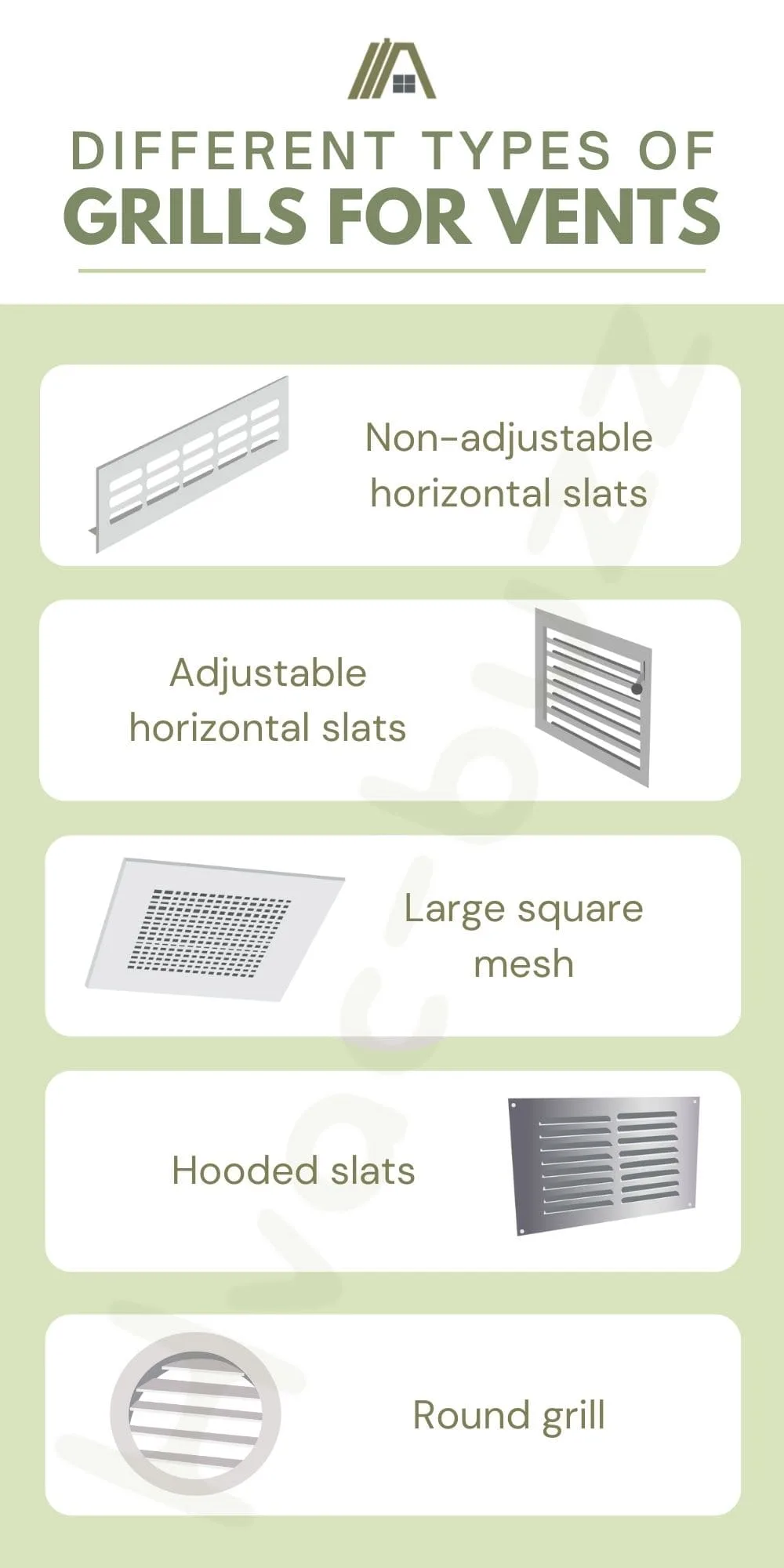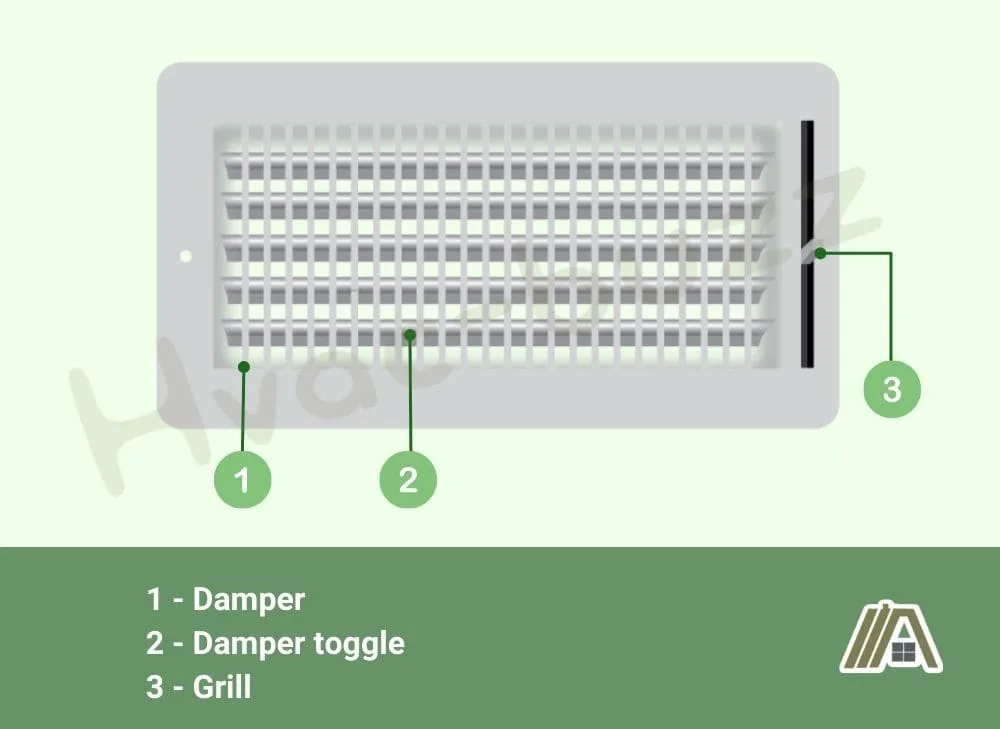
Vents are holes linking ducts to indoor or outdoor spaces. Grills are the vent coverings. Registers are the vents that supply air to rooms through slatted grills (with louvered dampers). Diffusers are a type of supply vent that provides 360° airflow through a specialized grill (with damper).
What Do They Have in Common?
The main commonalities of vents, grills, registers, and diffusers include facilitating the airflow of a home and being available in a wide variety of styles and colors.
What is a Vent?
Vents refer to the holes, typically round, square, or rectangular, in your house that connect to ductwork. This could be ductwork that is part of your HVAC system, or it may be more localized, like the ductwork for your bathroom exhaust fan, range hood, or dryer.
Please note that ‘vent’ is commonly used as an umbrella term, and in some cases, it may be used to describe one of the other parts used as vent covers which this article will cover.
Vents can either supply air to a room, remove air from a room, or release air outside. They are used for hot and cold air.
The term is not associated with one function more than another.
Vents can also be located in various places, depending on the purpose of the vent, which you can consider to be the type of vent.
Supply vents are often found in the upper portions of a room. Return vents are commonly found in the lower portions of the room.
Exhaust inlets can be on the ceiling, walls, and occasionally the floor (but this is uncommon). Then you have terminal vents, which lead to the outside (most often associated with localized exhaust systems).
Depending on the type of vent, a backdraft damper may be required.
Often, the actual covering of a vent is included in the term, but this is actually more accurately called the grill.
What is a Grill?
A grill is the covering of a vent. As they are used for almost all vents, they can be round, square, or rectangular. They also serve warmed, cooled, supplied, returned, and exhausted air, depending on the nature of the vent itself.
The location of the grill obviously depends on the location of the vent, but anywhere there is a vent on the inside or outside of the house, you are likely to find a grill there too.
The style of a grill ranges greatly and provides different looks as well as different functions.
The most common style is a horizontally-slatted look, with either fixed or adjustable slats. But you can also get a large square mesh look. You can also get hooded slats. Then you can get all of these options for round vents as well.

When there is the option to open and close a vent grill, it can be called a damper. Sometimes, the damper is separate from the grill and is something that closes over the entire vent just behind the grill.
A damper isn’t necessary for a grill. They typically come fixed because the air only needs to flow in one direction.

What is a Register?
A register is a specific type of vent. When we talk about registers, we are referring only to the vents that supply air into a room from the HVAC system.
Registers are used for both heating and cooling. Since they work to supply air to a room, they are only found inside homes (there are no registers on your outside walls; these are different kinds of vents).
In addition, since a register allows for the control of airflow, they come equipped with a damper. Typically, registers will come with a louver in terms of directionality.
A damper is especially useful with a register, as it aids its function of controlling airflow. This feature allows the register to manipulate the amount of air coming in, and to a certain extent, the direction in which this air enters the room. Both of these influence the heating and cooling effect.
You should note that closing a register in an unused room can have the opposite effect to what you are trying to achieve and it is not a practice recommended by any HVAC specialists that I have come across.
As registers are just vents with grills and a specific purpose, all the various styles of grill are available to make the registers look good in whatever setting you place them.
What is a Diffuser?
A diffuser is another type of vent that supplies air into a room. The differences between diffusers and registers are the appearance and mechanism of action.
While a register is typically square or rectangular (occasionally, it will be round), a diffuser is more likely to be round. It can also be square, but it’s almost never rectangular.
In addition, the diffuser will have a grill that helps the vent to provide 360° airflow, as you can see from the below sketch.
The greater control and ability to circulate air makes a diffuser a really good option in ceiling vents. There is no point in installing on the wall by the floor!
You may have guessed due to their nature that diffusers are only used on the inside of a home. They are used in conjunction with both heating and cooling systems.
To help give a diffuser its ability to control airflow, they are equipped with a damper. Most often, the dampers used in diffusers are round to fit with the overall shape of the ducts connected to the diffuser.
Finally, diffusers are also produced in a wide variety of colors, shapes, styles, and more to fit any aesthetic you may want to achieve in your home.
Table of Differences
| Vent | Grill | Register | Diffuser | |
| Supply or return air | Both | Both | Supply | Supply |
| Heating or cooling | Both | Both | Both | Both |
| Internal or external | Both | Both | Internal | Internal |
| Damper or fixed | Both | Both | Damper | Damper |
| Damper direction | Louvered/360° | Louvered/360° | Louver | 360° |
| Variety of designs | Yes | Yes | Yes | Yes |
How Do They All Interact?
Vents, grills, registers, and diffusers all work together in a home to create a cycle of airflow. Each of their functions collaborate to move air from the central system to the home and back again.
Although vents and grills are also involved in local systems.
Air is pulled into the HVAC system and heated or cooled depending on the season and the HVAC setting. This air is run through ducts to register or diffuser vents in specific rooms of the house.
The air passes through the damper and grill into the room.
Air, hot or cold, depending on the purpose of the running HVAC system, is then removed from the room through other vents, which are known as return vents.
These are so called because they return the air to the HVAC system and they are also often covered with grills.
This air is then carried back to the heart of the HVAC system to be heated or cooled again.
Sources
https://www.engineermd.com/2022/07/air-diffusers-in-hvac.html
https://www.mtlfab.com/index.php?pid=224&aid=595&pg=Ceiling+Diffuser+Damper
https://insights.jonite.com/grilles-registers-and-diffusers-what-is-the-difference


